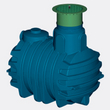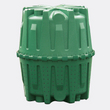|
|








|
 |
GRAF oferuje szeroką gamę produktów do zarządzania wodą. Obszerny asortyment obejmuje wszystko, od produktów do zbierania deszczówki i zarządzania wodami burzowymi, po magazynowanie i całkowite biologiczne oczyszczanie ścieków. |
| Ilość pracowników : |
220 |
| Rok założenia : |
1974 |
Rodzaj działalności : |
Manufacturer |
 Be smart and save – use rainwater Be smart and save – use rainwater
The company Otto GRAF GmbH from Teningen, founded more than 45 years ago, offers rainwater harvesting systems for individual as well as industrial use, in many different sizes and designs.
The company Otto GRAF GmbH from Teningen, founded more than 45 years ago, offers rainwater harvesting systems for individual as well as industrial use, in many different sizes and designs.
As a result of increased water consumption in the last several years, water is becoming increasingly scarce. Even more significant, however, than the problem of quantity is the water quality. Due to more and more extensive contamination with harmful substances, phosphates, pesticides and other chemical substances, water treatment is becoming not merely more difficult, but also more expensive. Statistics document that only one person (in Germany) uses, on average, 150 litres of valuable drinking water each day. However, for approximately 50% of uses, drinking-water quality is not imperative, e.g. for flushing the toilet, operating the washing machine, irrigating gardens and parks, operating a car wash, etc. Especially for these purposes, the use of rainwater enables savings of approx. 75 litres per person and per day.
In addition to cost savings, the use of rainwater involves additional advantages:
• it is free of charge
• it must not be pre-treated
• it offers protection from calcification of the washing machine
• it is an optimum medium for plants to absorb minerals, etc.
The collected rainwater is channelled through a preliminary filter (e.g., a Graf Optimax filter) into the rainwater reservoir. This can be installed underground, or also above ground. From there, the water is carried with the aid of a pump via separately laid mains to the user stations. Should a drought occur, drinking water is supplied to the mains via an automatic replenishment system.
Although the filters typical to this market are equipped with fine strainer inserts, small dust particles do accumulate in the rainwater tank. These particles collect at the bottom of the tank to form a layer of sediment, and gradually convert to minerals. The sediment layer is absolutely significant to the water quality and should not be destroyed by re-suspension or too-frequent cleaning of the tanks. Therefore, the tank should only be cleaned every 10 to 15 years. Also, any concerns regarding the hygienic quality of the rainwater can be dispelled. In this regard, scientific studies have indicated that rainwater harvesting systems designed according to the latest insights warrant sufficient purification of the rainwater.  Modular system covers manifold applications Modular system covers manifold applications
The Graf brand has stood for innovations in plastic products for more than 45 years.
The Graf brand has stood for innovations in plastic products for more than 45 years. Graf is presenting the new Carat S wastewater tank to the public for the first time at the IFAT in Munich from 5th to 9th May 2008. “The wastewater tank is the next logical step in the Carat model range”, reports Graf Managing Director Otto P. Graf. The tank series, which is already successfully introduced for rainwater harvesting, now meet the necessary requirements equipped with a flexibly positioned baffle and CE certification.
With this new product, Graf is now also setting new standards in the wastewater sector with regard to quality and stability of plastic tanks. The Carat is produced using injection moulding – an unique production method worldwide for tanks of this size. This gives the components of the underground tank extraordinary fitting accuracy. Its construction with an encircling H-profile guarantees high stability: The Carat can be installed in groundwater up to the middle of the tank. Additionally, load-bearing capacity of up to 12 tons can be realised when combined with an appropriate tank cover. The tank is available in sizes 2,700, 3,750, 4,800 and 6,500 litres. Sets of two or more underground tanks are offered for larger storage volumes.
Graf has already accessed the export markets with the export version of the underground tank, the Carat S. The Carat S tank is consisting of two stackable half-shells. This unique product design allows to ship up to 8 times more tank volume compared to a conventionally designed tank.
Graf is offering a module system for wastewater around the Carat S, which means that tailor-made solutions can be put together for any application. In addition to the underground tank, the three components of cover, baffle and technical pack can be selected individually. Thus, different systems emerge, from the sealed collection tank, to multi-chamber tanks, up to fully biological treatment systems.
Firma Otto Graf GmbH od 40 lat oferuje wysokiej jakości produkty z tworzyw sztucznych. Firma rozpoczęła działalność od produkcji produktów z tworzyw sztucznych do winiarstwa, takich jak beczki na wino i wiadra do zbioru. Jednak ciągły wzrost GRAF był również wynikiem udanej sprzedaży kompostowników i pojemników z tworzyw sztucznych dla przemysłu. Graf jako pierwszy opracował produkty do zbierania deszczówki w 1974 roku – wówczas był to pionierski krok. Dziś większość obrotów pochodzi z produktów związanych z zarządzaniem wodami deszczowymi.
Zobowiązanie do Niemiec jako lokalizacji
GRAF inwestuje ponad 20 milionów euro w nowy zakład produkcyjny w siedzibie firmy w Teningen koło Fryburga (Badenia). Tutaj, na powierzchni 155 000 m2 - co odpowiada 31 boiskom piłkarskim - powstał jeden z najnowocześniejszych zakładów produkcyjnych produktów z tworzyw sztucznych na świecie. Wybór Niemiec jako lokalizacji był prosty. Z jednej strony czujemy zobowiązanie do tego miejsca z powodu naszej historii. Z drugiej strony chcielibyśmy oferować naszym klientom produkty najwyższej jakości. Jest to możliwe tylko dzięki wykwalifikowanej i zmotywowanej kadrze. W związku z tym inwestycja w kraj o niskich płacach nigdy nie była rozważana.

| Diamond drinking water reservoir Zbiornik na wodę pitną Diamond, Pojemniki wykonane z wytrzymałego polietylenu o długiej żywotności. Konstrukcja bezpieczna dla żywności z certyfikatem testowym zgodnie z zaleceniem KTW. Łatwe w transporcie, instalacji i szybkim montażu dzięki niskiej wadze. Łatwe w czyszczeniu dzięki gładkim wewnętrznym powierzchniom zbiornika. Testowane pod kątem bezpieczeństwa przez TÜV.
| 
| Herkules percolation shaft Szyb Herkules, Testowany pod kątem bezpieczeństwa przez TÜV. Produkt roku przyznany przez Niemieckie Stowarzyszenie Handlowe Przetwórstwa Tworzyw Sztucznych (FKVV). Koszt-efektywny dzięki dobremu stosunkowi ceny do wydajności. Patentowane szybkie połączenie (do montażu nie są potrzebne śruby). Trwała uszczelka dzięki solidnemu profilowemu uszczelnieniu (żywotność ponad 25 lat udowodniona w testach laboratoryjnych). Możliwość rozbudowy w razie potrzeby. | |
|
|

